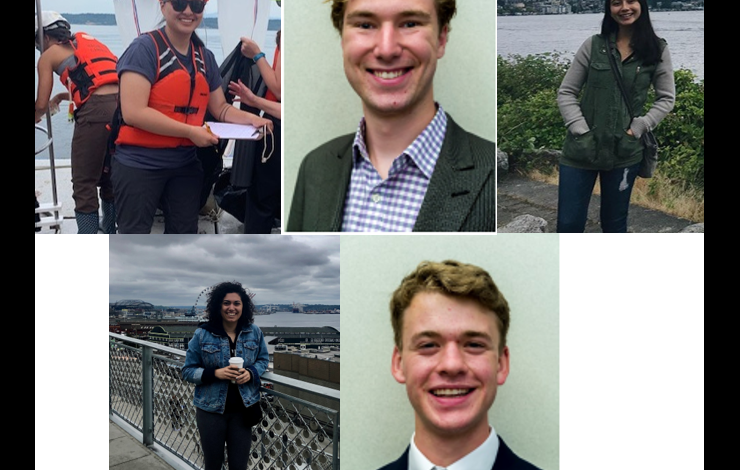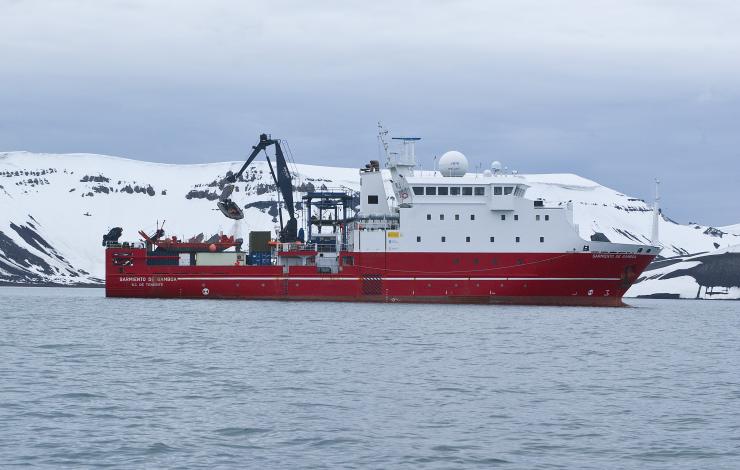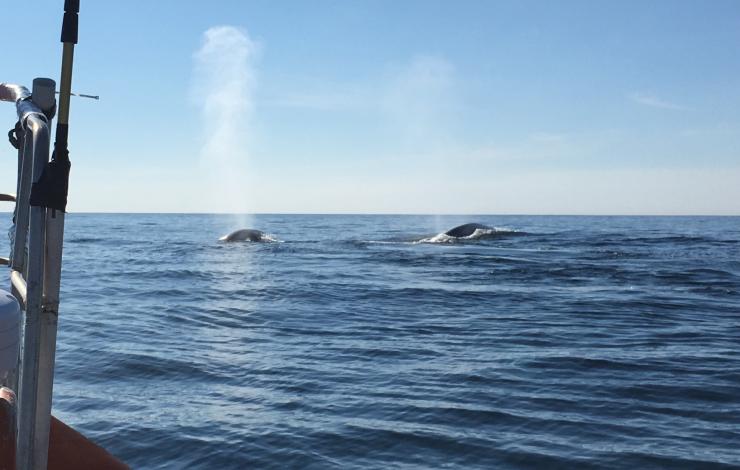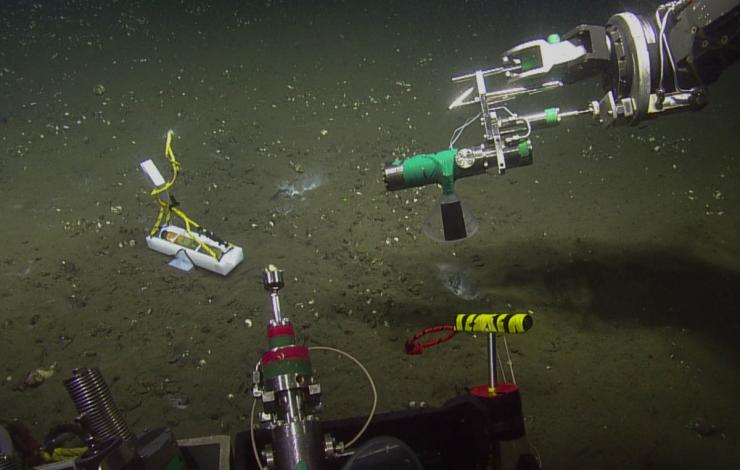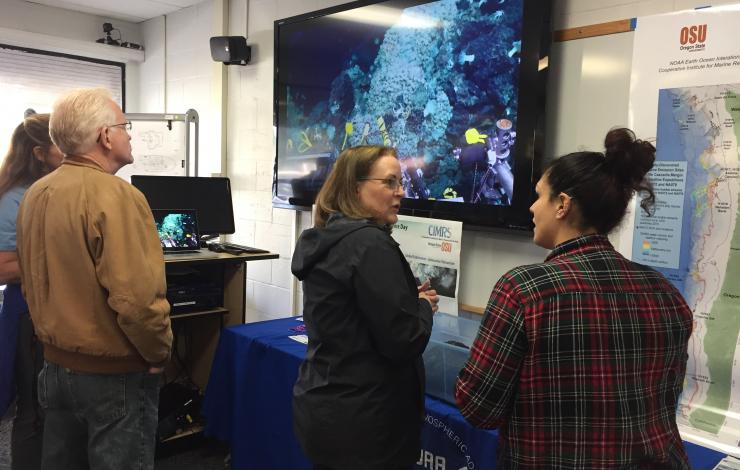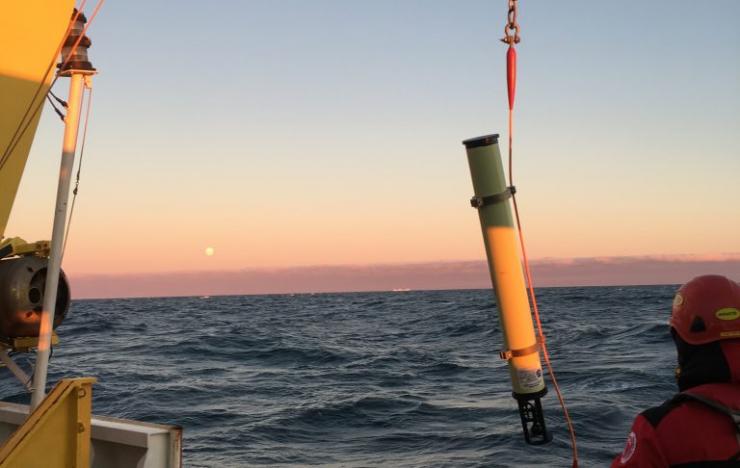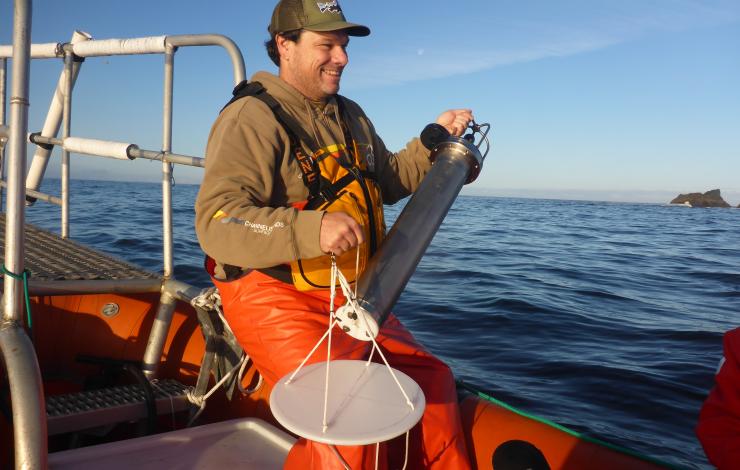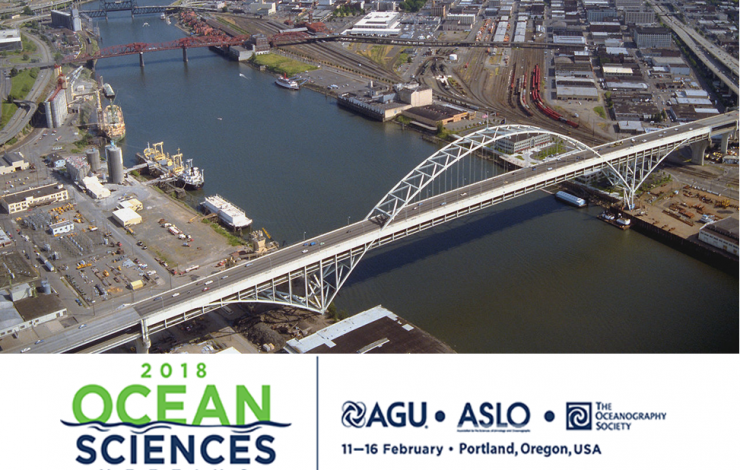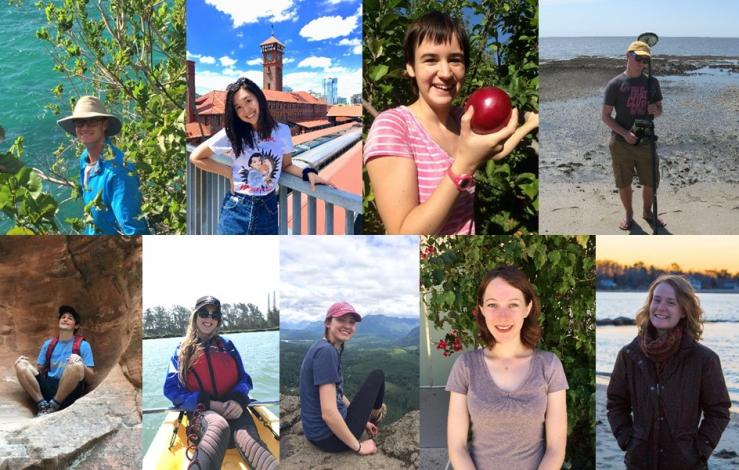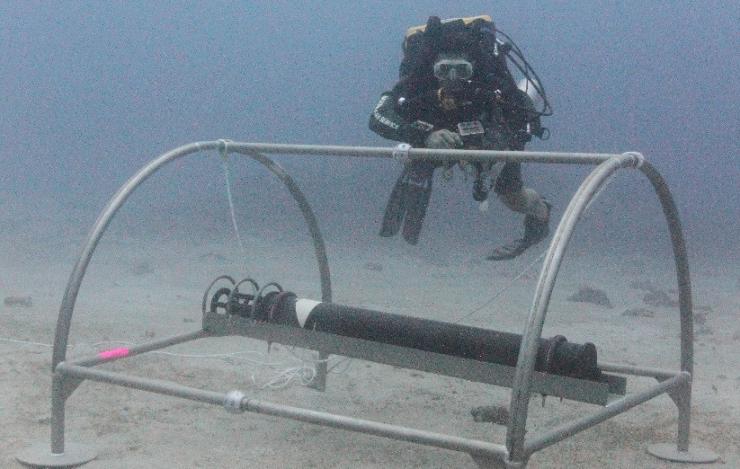What's New Archive
PMEL is excited to host seven undergraduates this summer from across the United States! They are working across various research groups studying ocean carbon, Madden-Julian oscillation impacts, meteorological data from Station Papa, fisheries-oceanography research in the Bering Sea, acoustic data from the Ross Sea, and analyzing e-DNA samples. The students are supported through NOAA, University of Washington’s Joint Institute for the Study of the Atmosphere and Ocean (JISAO) internship program, and Oregon State University’s Research Experience for Undergraduates.
Harrison Knapp is a NOAA Hollings Scholar working with Dr. Chidong Zhang on assessing the influence of the Madden-Julian Oscillation on snowpack in the Western United States. He is currently a student at the University of Southern California pursuing both a B.S. in GeoDesign and a B.A. in Earth Sciences.
Sam Mogen is a NOAA Hollings Scholar working with Drs. Jessica Cross and Darren Pilcher on exploring oxygen cycling in the Bering Sea using the Bering 10K model. He is a student at the University of Virginia studying environmental science and global studies.
Madeline Talebi is a JISAO intern working with Drs. Meghan Cronin and Nick Bond on finding and interpreting archived meteorological data from Station Papa Ocean Weather Ship between December 1949 and 1981. She is currently studying Chemical Engineering at the University of California, Irvine.
Isabelle Chan is a JISAO intern working on decreasing the degree of uncertainty between water vapor and carbon dioxide measurements with Dr. Sophie Chu. She is currently studying Environmental Science with an emphasis in Conservation at the University of North Carolina, Wilmington.
Leo MacLeod is a undergraduate at the University of Washington working with Dr. Carol Ladd on fisheries-oceanography research in the Bering Sea.
Ellie Lee is a JISAO intern working with Dr. Carol Stepien in the Genetics and Genomics Group.
Miriam Hauer-Jense is working with Drs. Bob Dziak and Joe Haxel on analyzing data from the Ross Sea hydrophones for marine mammals through Oregon State University’ Research Experience for Undergraduates program. She is a sophomore at Scripps College.
Read more about each of them and their projects here.
PMEL staff at the NOAA Cooperative Institute for Marine Research Studies at Oregon State University recently participated on a hydrophone deployment cruise aboard the Spanish R/V Sarmiento de Gamboa in the Bransfield Strait off the western Antarctic Peninsula along with colleagues from the University of Washington, Woods Hole Oceanographic Institute, Queens College and the University of Granada (Spain) from January 4 - 17. PMEL successfully deployed 6 hydrophone moorings, while the University of Washington, Woods Hole and Queens College deployed 30 ocean bottom seismometers, and the University Granada deployed 20 land-based seismic stations.
The Bransfield Strait region is a highly volcanic area, with multiple, recently active, submarine and subaerial volcanoes including the active Deception Island volcano which last erupted in 1970 damaging the Spanish Antarctic base located there. Thus the goal of the project is to assess the volcanic hazard to the collection of international polar bases located in this part of Antarctica, as well as to better understand the ocean soundscape and sea-ice dynamics in the region. Using both active and passive seismo-acoustic data collection techniques, researchers will be able to image shallow pockets of magma in the crust that are likely distributed throughout the entire area. This research is funded by the National Science Foundation Antarctica Program.
Learn more about PMEL's Acoustic Program here: https://www.pmel.noaa.gov/acoustics/
On October 17, 2018, a joint NOAA/PMEL and Oregon State University Marine Mammal Institute (OSU-MMI) team, with the assistance of a U.S. Coast Guard helicopter on patrol providing real time radio reports of cetacean sightings, traveled 27 miles off the Oregon coast (due west of Newport, Oregon) to acquire acoustic recordings and biopsy two North Pacific blue whales. Through MMI contacts, the Coast Guard helicopter out of North Bend spotted blue whales off shore during routine patrol, and alerted the team to their approximate location.
A PMEL drifting hydrophone was used to record the blue whale calls, while OSU-MMI personnel successfully collected a biopsy sample of one of the two blue whales, and documented the encounter with photographs. Genetic results show the biopsied animal was a male, acoustic analysis of call signal strength shows two animals observed during biopsying were likely source of recorded vocalizations. The researchers are currently doing further genetic analysis and photo identification work to confirm blue whale population and gender of animals recorded. These data will be used to correlate the genetic identity and acoustic call type of a North Pacific blue whale.
The goal is to quantify and relate call signal characteristics and genetic identity. Typically, only remote recordings of blue whale calls are used to assess population size and distribution of this endangered species.
All research was conducted under NMFS permit 20465 with the support of the Marine Mammal Institute whale telemetry group.
PMEL's Acoustic and Earth-Ocean Interactions programs have successfully recorded the sound of methane bubbles from the seafloor off the Oregon coast using a hydrophone, opening the door to using acoustics to identify - and perhaps quantify - this important greenhouse gas in the ocean. Methane is found both as an icy hydrate deposit and in a gas phase within the sediments of the continental margins. The methane stored in the Cascadia margin, located offshore Washington, Oregon, and northern California, is of particular interest because the methane is stored within a major subduction zone which can potentially have an environmental impact on the upper water column and possibly the atmosphere.
In recent years, scientists have found hundreds of bubble streams emanating from methane deposits off the Pacific Northwest coast, but they have no way to determine how much methane is stored there. In 2016, researchers used the remotely operated vehicle (ROV) Hercules from the Ocean Exploration Trust's Exploration Vessel (E/V) Nautilus to deploy a hydrophone about 6 miles off Heceta Bank on the Oregon continental margin in 1,228 meters of water (about three-fourths of a mile deep). The acoustic signatures of the bubbles from the seep site are depicted in the hydrophone record as a series of short, high-frequency bursts, lasting 2-3 seconds.
"The bubbles in the streams make sound, and the frequency of the sound is related to the size of the bubble," said Robert Dziak, an acoustics scientist with the National Oceanic and Atmospheric Administration and lead author on the study. "The smaller the bubble, the higher the pitch. And the larger the bubble, the lower the sound pitch, but the more methane it contains.
The researchers then compared the sound record with still images from the ROV and found their estimates of bubble size from the hydrophone record matched the visual evidence. Results of the study have just been published in the journal Deep-Sea Research II.
On the current Nautilus research cruise mapping methane seeps, a hydrophone was deployed and recovered at various depths of Astoria Canyon in order to compare how bubble sizes and rates change with depth.
The next step, researchers say, is to fine-tune their ability to detect the acoustic signature of the bubbles so they can use the sounds to estimate the volume of methane in the offshore reservoirs. The ultimate goal is to be able to use sound to estimate the volume and rate of methane gas exiting the seafloor.
Join PMEL at Marine Science Day THIS SATURDAY, April 14, at the Hatfield Marine Science Center, in Newport, OR. Join tours, meet scientists, and get a behind-the-scenes look at the research, education, and outreach in marine sciences that makes this marine laboratory unique in the Pacific Northwest. Admission is FREE and open to the public. There will be interactive research exhibits that will feature emerging ocean observing technologies, bioacoustics of whales, video of volcanoes and deep ocean vents, and a new video on the emerging issue of ocean acidification. Activities for children and families can be found throughout the event.
PMEL will have two booths highlighting the work done at underwater volcanoes around the world and locally at Axial Seamount and ocean noise. You'll be able to view videos from recent expeditions and listen to various recorded sounds.
More information can be found here: https://hmsc.oregonstate.edu/marinescienceday
The PMEL Acoustics Program is back in the Ross Sea in Antarctica replacing six hydrophones that record icequakes, iceberg tremors and other naturals sounds near the Drygalski and Nansen Ice Shelves. The data collected from these hydrophones over the last four years will allow the Acoustics program to characterize the soundscape of the Terra Nova Bay polynya and to assess ice flow dynamics, as well as marine mammal presence/distribution in the newly formed Antarctic Marine Protected Area.
Ice shelves are permanent floating sheets of ice that connect to a landmass and are mostly found around the coast of Antarctica. They also slow the rate of ice flow from glaciers and ice streams coming into the ocean from the interior of the land. If an ice shelf collapses, then the glaciers flow more quickly out to the ocean and can accelerate sea level rise. Sea shelves can also calve, or split apart, as seen when two iceberg broke away from the Nansen ice shelf in April 2016 due to the largest low pressure storm system in more than a year that ultimately caused the icebergs to break free of the Nansen shelf.
The PMEL Acoustics Program has been collaborating with the Korea Polar Research Institute (KOPRI) for several years on multiple projects in Antarctica.
At the Ocean Sciences Meeting this week, Dr. Joe Haxel with Oregon State University's Cooperative Institute for Marine Resources Studies and PMEL's Acoustic Program presented findings from acoustic recordings from a series of drifting hydrophone deployments off of the Oregon coast from May-October 2016. The hydrophone recorded loud sounds characteristic of snapping shrimp, which are typically found in warm, shallow subtropical waters all over the world, but are undocumented in the colder coastal waters off the coast of the Pacific Northwest, until now. Analysis of the recordings provide estimates of the number of snapping shrimp along the central and southern Oregon coasts and their activity levels.
In addition to discovering the presence of snapping shrimp, the researchers found eastern Pacific gray whales were often foraging near the rocky reefs the shrimp inhabit. Gray whales don't eat snapping shrimp, but they do eat other types of prey usually found near the rocky reefs, in particular mysids. Joe Haxel and his colleagues suspect the loud snaps and crackling din of the snapping shrimp could be an acoustic cue to direct whales to areas of the ocean where their typical food might be plentiful.
The discovery is part of a larger effort by researchers to better understand the acoustic environment of Pacific Northwest coastal waters. By deploying the hydrophones, they hope to characterize the volume and types of sounds animals hear in Pacific Northwest waters. The new research shows snapping shrimp are an important contributor to the coastal soundscape, Haxel said.
Read the press release from AGU here.
More than 50 PMEL scientists, including scientists from NOAA, University of Washington's Joint Institute for the Study of the Ocean and Atmosphere (JISAO), Oregon State University's Cooperative Institute for Marine Resources Studies (CIMRS) and the National Research Council, will present a talk or share a poster on their research at the 2018 Ocean Sciences Meeting in Portland, Oregon February 12-16, 2018. PMEL research groups that will be present at the conference are: Acoustics, Arctic, Earth-Ocean Interactions, EcoFOCI, Engineering, Global Tropical Moored Buoy Array, Innovative Technology for Arctic Exploration, Large Scale Ocean Physics, Ocean Carbon, Ocean Climate Stations, Pacific Western Boundary Currents, Science Data Integration Group, Thermal Modeling and Analysis Project
28 talks will present research on ocean carbon, ocean acidification, ocean observing systems, Arctic research including the Distributed Biological Observatory and Arctic Marine Pulses (AMP), ENSO, MJO, hydrothermal vents, Saildrone research, air-sea interactions, SOCCOM, and ocean mixing. 26 posters will be up during the poster sessions and highlight research in the Arctic, hydrothermal vents, acoustics, methane bubbles and hydrates, Saildrone, Oculus Coastal Glider, ocean carbon, deep ocean temperatures, glider research in the Solomon Sea, and ocean acidification and hyopxia.
PMEL staff will also be chairing sessions and workshops on:
- El Nino-Southern Oscillation (ENSO) Diversity, Predictability, and Impacts
- Western Pacific and Indonesian Sea Circulation and Its Environmental and Climatic Impacts
- New Platform and Sensor Technologies: Advancing Research, Readiness, and Transitioning for Sustained Ocean Observing of Essential Ocean Variables
- Methane from the Subsurface Through the Bio-, Hydro-, and Atmosphere: Advances in Natural Hydrate Systems and Methane Seeps in Marine Ecosystems
- Cascadia Margin methane seep and hydrates to share results and coordinate future work
The 2018 Ocean Sciences Meeting is co-sponsored by the American Geophysical Union (AGU), the Association for the Sciences of Limnology and Oceanography (ASLO), and The Oceanography Society (TOS). The meeting is an important venue for scientific exchange across broad marine science disciplines. Sessions will include all aspects of oceanography, especially multidisciplinary topics, as well as presentations that reflect new and emerging research on the global ocean and society, including science education, outreach, and public policy
This summer, PMEL is hosting 9 undergraduate students through the NOAA’s Ernest F. Hollings Scholarship program, NOAA’s College-Supported Internship Program at Smith College, the National Science Foundations’ Research Experience for Undergraduates, and the University of Washington’s Joint Institute for the Study of the Atmosphere and Ocean (JISAO) internship program. They are working across multiple groups at PMEL: Acoustics, Earth Ocean Interactions, Atmospheric Chemistry, Ocean Acidification, Madden-Julian Oscillation (MJO), and Large Scale Ocean Physics. The students spend 10 weeks at PMEL with their mentors getting hands-on research experience at both the Seattle and Newport locations. They are all so passionate and can't wait to see what they accomplish this summer.
This year's cohort are: Will Christian from Michigan Technological University, Tina Chen from Middlebury College, Max Garvue from University of Nebraska - Lincoln, Nick Barber from Drexel University, Danielle Naiman from the University of California - San Diego, Gabby Kalbach from California State University - Monterey Bay, Sophie Shapiro and Courcelle Stark from Smith College, Emily van Auken from Stonehill College. Read more about each of them and their projects here.
Learn more about NOAA’s Ernest F. Hollings (Hollings) Undergraduate Program, the National Science Foundation Research Experience for Undergraduate (NSF-REU) program, JISAO summer intership program, and the NOAA College-Supported Internship Program.
This week, the US Virgin Island National Park will deploy the 12th Noise Reference Station in the National Park. PMEL's Acoustic program built the hydrophone and provided the instrumentation and software. Identical hydrophones have been deployed at the other reference stations to ensure consistency across the data sets. Data collected by the NOAA Ocean Noise Reference Station Network contributes to national monitoring efforts and assesses potential noise impacts on marine resources, including endangered marine mammals and fish. This Noise Reference Station is part of a large-scale effort to monitor long-term changes and trends in underwater sound across U.S. water. The network of stations provide fundamental data to understand what ambient ocean sound levels are now, how they're changing over time and how man-made noise, such as from shipping, may be impacting marine life. The locations of the network range from as far north as the Arctic coast of Alaska to American Samoa in the South Pacific.
This project is a collaboration with a variety of partners, including NOAA’s National Ocean Service (NOS), NOAA’s National Marine Fisheries Services Science Centers, NOS National Marine Sanctuary System, and Department of the Interior’s National Park Service. For more information on this collaborative project, see NOAA/PMEL Ocean Noise Reference Station Network, and the NOAA/NMFS-OST feature story.



